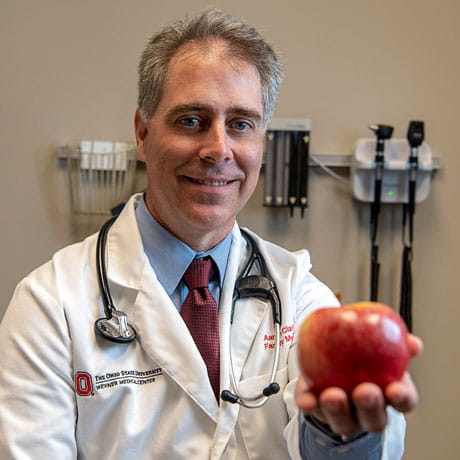OSU family docs and Mid-Ohio Pantries team up to address food insecurity
 Physicians at The Ohio State University Department of Family Medicine are anxious to find out if health outcomes for patients identified as “food insecure” improve if given increased access to fresh fruits and vegetables in their neighborhoods.
Physicians at The Ohio State University Department of Family Medicine are anxious to find out if health outcomes for patients identified as “food insecure” improve if given increased access to fresh fruits and vegetables in their neighborhoods.
Food insecurity is a growing problem in the United States, with more than 12 million children living in “food insecure” homes, according to the U.S. Department of Agriculture (USDA). As many as one in four children in Ohio are unsure of where their next meal is coming from, according to the Children’s Hunger Alliance, with approximately 630,000 children statewide living in food-insecure households. In Franklin County alone, hungry Ohioans miss around 69 million meals each year.
Much of the blame for food insecurity can be placed on the social determinants that limit access to fresh, healthy nutritional foods for certain vulnerable populations due to restrictions related to location, transportation availability or poverty.
In response, communities in Columbus, Ohio, are pulling together to get at the root causes of hunger by improving access to fresh produce to those in need through a program that includes a “prescription” from the patient’s care team. One such effort, the Mid-Ohio Farmacy pilot program, combines the medical services of The Ohio State University Wexner Medical Center’s Family Medicine Department with the food services available through the Mid-Ohio Foodbank.
Working as a team led by program director Aaron Clark, DO, associate professor of Clinical Family Medicine at The Ohio State University College of Medicine, physicians at Ohio State Family Medicine Outpatient Care East, Thomas Rardin Family Medicine and McCampbell Outpatient Care are hopeful they will find a measureable correlation between access to fresh food and health improvements in their sample, some 500 patients who have been diagnosed with specific conditions known to be prevalent in these vulnerable communities, including uncontrolled diabetes, gestational diabetes, uncontrolled hypertension and obesity.
Enrollees are provided with a treatment plan, along with a nutrition program that includes a diet of fresh fruits and vegetables, obtainable at any of 12 participating food pantries located throughout Columbus’ inner-city neighborhoods. “Purchases” are made with a scannable “prescription” card, which may be used as often as once a week to encourage health eating habits, while providing data about what patients are eating and how often. In combination with frequent monitoring of their vital signs — glucose, blood pressure, weight and other indicators of health — data gathered from the prescription card records allows researchers to measure whether the changes in dietary behavior are showing longitudinal signs of improved health in these patients.
So far, 75 patients have been screened and enrolled in the Ohio State program since opening in September.
Patients may enroll at one of three OSU facilities: Family Medicine Outpatient Care East, Thomas Rardin Family Medicine and McCampbell Outpatient Care.

